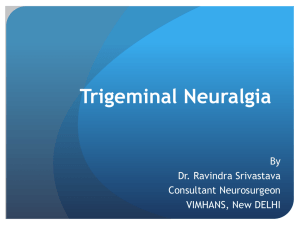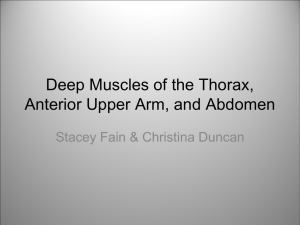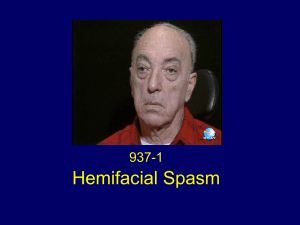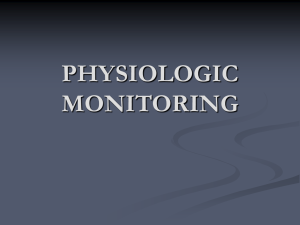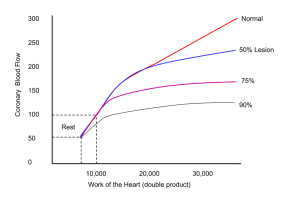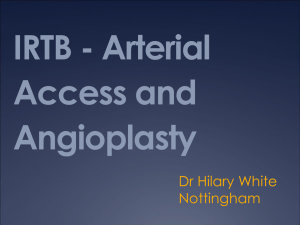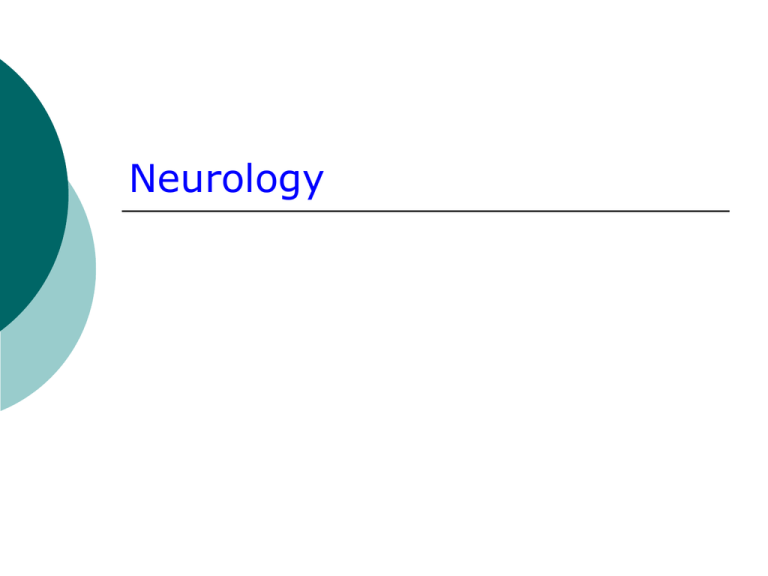
Neurology
NEUROLOGY
CHAPTER 24
Symptoms: Headache (HA)
Acute:
Age > 50 years.
Rapid onset and severe intensity.
Fever.
Trauma.
Vision changes.
Past medical history of hypertension or HIV infection.
Hypertension.
Neurologic findings (mental status changes, motor or sensory
deficits).
3
Headches
Chronic:
Migraine (pulsating or throbbing),
Tension (tightness or pressure ), or
Depression
Tumor, head injury, cervical spondylosis, dental or
ocular disease, TM joint dysfunction, sinusitis,
hypertension
4
Headaches
Sharp and lancinating – neuralgic
Ocular/periorbital-icepick like pain- migraine/cluster
headaches
Dull and steady- tumor
Cough aggravated in brain tumors
Severe headache in a previously well patient: rule outsub arachnoid hemorrhage/ meningitis
5
Headaches
Cranial MRI or CT scan required if:
New onset in middle or later life
Progressive
Disturb the sleep/related to exertion
Associated with neurological deficit
6
Tension Headaches
Poor concentration
Vague non specific symptoms
Vise-like, worse on emotional stress/noise/
glare and occurs almost daily
Intense around back of the neck & head
May respond to Tylenol/ or migraine medicine
Relaxation therapy/Massage/Hot baths/
Biofeedback/?Botox
7
Depression HA
Worse on waking up
Associated depressive symptoms
Antidepressants/Psychiatric help
8
Migraine HA
Headache, usually pulsatile/dull/throbbing.
Nausea, vomiting, photophobia, and
phonophobia are common
Transient neurologic symptoms (commonly
visual) preceding headache of classic
migraine.
No preceding aura is common.
9
Migraine
Related to serotonin (5-HT)
Trigeminal trigger
Episodic lateralized throbbing headache
Late teen/early adult onset
Anorexia/Nausea/Vomiting
Visual/Auditory disturbances- gradual build up, last
several hours
External Carotid artery system dilation/pulsation
Focal neurological signs/symptoms due to initial
constriction of ICA
10
Migraine
Visual: common field defects
luminous visual hallucinations such as stars,
sparks, unformed light flashes, geometric patterns,
or zigzags of light
Aphasia/numbness/tingling/clumsiness
11
Migraine
FH+
Factors- emotional stress, lack/excess sleep, missed
meals, specific food items (chocolate, alcohol),
menses, pill
‘Basilar artery’ migraine- blindness/visual field
defects initially and later- tinnitus/perioral tingling
and transient loss of consciousness/ confusion
followed by throbbing occipital HA, nausea/vomiting
12
Migraine: Treatment
AVOID! Factors
Prophylactic treatment:
aspirin/brufen/allieve
Ergot + caffeine (vasoconstrictor)
Serotonin blockerSumatriptan/Zolimtriptan
13
Table 24–1. Prophylactic treatment of migraine.
Drug
Usual Adult
Daily Dose
Common Side Effects
Propranolol
80–240 mg
Fatigue, lassitude, depression, insomnia, nausea,
vomiting, constipation.
Amitriptyline
10–150 mg
Sedation, dry mouth, constipation, weight gain,
blurred vision, edema, hypotension, urinary retention.
Imipramine
10–150 mg
Similar to those of amitriptyline (above).
Sertraline
50–200 mg
Anxiety, insomnia, sweating, tremor, gastrointestinal disturbances.
Fluoxetine
20–60 mg
Similar to those of sertraline (above).
Cyproheptadine
12–20 mg
Sedation, dry mouth, epigastric discomfort,
gastrointestinal disturbances.
Clonidine
0.2–0.6 mg
Dry mouth, drowsiness, sedation, headache,
constipation.
Verapamil2
80–160 mg
Headache, hypotension, flushing, edema, constipation.
May aggravate atrioventricular nodal heart block
and congestive heart failure.
14
Cluster Headache
(Migrainous Neuralgia)
1.
2.
3.
4.
5.
Predominantly middle-aged men
?Vascular/?serotonin
No FH+
Unilateral periorbital pain withipsilateral nasal congestion,
rhinorrhea,
lacrimation,
redness of the eye, and
Horner's syndrome
15
Horner syndrome
Results from an interruption of the sympathetic
nerve supply to the eye, and is characterized by
the classic triad:
1 Miosis (ie, constricted pupil)
2 Partial ptosis and
3 Loss of hemifacial sweating (ie, anhidrosis)
16
Cluster Headache
(Migrainous Neuralgia)
AT night (wakeup)
Lasts <2hrs
Spontaneous remission
?alcohol trigger/ glare/food
17
THERAPY
Oxygen (acute attack)
Oxygen (8 L/min for 10 min or 100% by mask) may abort the headache if used early.
Mechanism of action is unknown.
Sumatriptan
Most studied of the triptans in cluster headache.
Subcutaneous injections can be effective, in large part, due to the rapidity of onset.
No evidence suggests that they are effective orally.
Dihydroergotamine
Can be abortive agent
IV/IM; self-injections
18
Posttraumatic Headache
Closed head injury
Worsen over the ensuing weeks, and then gradually
subsides
Disequilibrium, enhanced by postural change or head
movement
Impaired memory, poor concentration, emotional
instability, and increased irritability
Tests not helpful, Treatment difficult
19
?
20
TRIGEMINAL NERVE
21
22
Trigeminal Neuralgia
Brief episodes of stabbing facial pain.
Pain is in the territory of the second and
third division of the trigeminal nerve.
Pain exacerbated by touch
Middle and later life (F>M)
23
Trigeminal Neuralgia
Sudden lancinating facial pain occur
commonly arise near one side of the mouth and shoot toward
the ear, eye, or nostril on that side
Trigger-touch, movement, drafts, and eating
Pain become more frequent, remissions become shorter and
less common, and a dull ache may persist between the
episodes of stabbing pain
Confined to the distribution of the trigeminal nerve (usually
the second or third division
24
Trigeminal Neuralgia
Young patient presenting with trigeminal neuralgia,
multiple sclerosis
Tests-evoked potential testing and examination of
cerebrospinal fluid may be corroborative
Treatment- carbamazepine (Tegretol)/ Baclofen/
Gabapentin
Nerve ablation
Structural cause for the neuralgia (despite normal
findings on CT scans, MRI, or arteriograms) -surgery
25
TCM Diagnoses and
Acupuncture Treatments
Etiology & Pathology:
Exterior –WIND-COLD
Invasion
Interior – LV/ST FIRE
Interior – YIN DEFICIENCY
w/empty fire rising
Differentiation:
Wind-Cold Invasion
Signs & Symptoms:
Acute onset, severe pain
for a few seconds to a few
minutes several times/day
Exterior signs, runny nose,
tearing
Tongue: Thin white coat
Pulse: Tight, floating
LV/ST Fire
Signs & Symptoms:
Severe pain w/irritability
Internal heat signs, thirst,
constipation
Tongue:Yellow, dry coat
Pulse: Wiry
Yin Deficiency w/empty heat
rising
Signs & Symptoms:
Pain is more insidious, gradual,
comes and goes, malar flush,
soreness in lumbar area
Tongue: Red w/no coat
Pulse: Thin, fast
26
Treatment Points
For pain in the supraorbital region:
Local: Taiyang
GB14/ UB2
Distal: TH5 / LI4
For pain in the maxillary region:
Local: ST2 / SI 18 / LI 20
Distal: LI4
For pain in the mandibular region:
Local: ST6 / ST 7
Extra point 1 cun lateral to CV24
Distal: LI4
Wind-Cold : Add GB 20
LV/ST Fire: Add LV3, possibly LV2, ST44
Yin Deficiency : Add KD6, SP6
27
Glossopharyngeal Neuralgia
Occurs in the throat, about the tonsillar
fossa, and sometimes deep in the ear and
at the back of the tongue
Precipitated by swallowing, chewing,
talking, or yawning
28
Postherpetic Neuralgia
15% of patients who develop shingles
suffer from postherpetic neuralgia
High risk: elderly and involvement of
Ophthalmic (I)
division
Incidence of postherpetic neuralgia may be reduced by the
treatment of shingles with oral acyclovir or famciclovir (?)
Corticosteroids do not help (?)
Zoster vaccine for elderly (?)
ZOSTAVAX® [Zoster Vaccine Live (Oka/Merck)]
Carbamazepine/TCA/Lidocaine (local)
29
Epilepsy
Recurrent seizures.
Characteristic electroencephalographic
changes accompany seizures.
Mental status abnormalities or focal
neurologic symptoms may persist for hours
postictally
Seizure is a transient disturbance of cerebral
function
30
Epilepsy
Usually begin between 5 and 20
Congenital abnormalities and perinatal injuries
Alcohol withdrawal/hypo or hyper glycemia
Trauma (within 2 years following the injury)
Tumors-especially important cause of seizures in middle and
later life , must be excluded by appropriate imaging studies in
all patients with onset of seizures after 30 years of age
31
RED FLAGS!Epilepsy
Epilepsy-Old age –
Vascular diseases
Alzheimer's disease
Infectious disease-
AIDS
∆bacterial meningitis or herpes encephalitis
32
Seizure Type
Key Features
I: Partial seizures
Involvement of only restricted part of brain; may
become secondarily generalized
Other Associated Features
1) Simple partial
Consciousness preserved
May be manifested by focal motor, sensory, or
autonomic symptoms
2) Complex partial
Consciousness impaired
Above symptoms may precede, accompany, or
follow
II: Generalized seizures
1) Absence (petit mal)
Diffuse involvement of brain at onset
Consciousness impaired briefly; patient often unaware of
attacks
May be clonic, tonic, or atonic components (i.e.,
loss of postural tone); autonomic components
(e.g., enuresis); or accompanying automatisms
Almost always begin in childhood and
frequently cease by age 20
2) Atypical absences
3) Myoclonic seizures
4) Tonic-clonic (grand mal)
May be more gradual onset and termination than typical
absence
More marked changes in tone may occur
Single or multiple myoclonic jerks
Tonic phase: Sudden loss of consciousness, with rigidity
and arrest of respiration, lasting < 1 minute
May be accompanied by tongue biting,
incontinence, or aspiration; commonly
followed by postictal confusion variable in
duration
Clonic phase: Jerking occurs, usually for
< 2–3 minutes
Flaccid coma: Variable duration
III:
Status epilepticus
Repeated seizures without recovery between them; a
fixed and enduring epileptic condition lasting 30 minutes
33
Tests
Imaging? new onset of seizures after the age of 20
years,
A chest radiograph should also be obtained
in such patients, since the lungs are a
common site for primary or secondary
neoplasms.
34
Tests
EEG
CBC
Blood glucose
BUN, Creatinine
35
DD
TIAs
Rage attacks
Panic attacks
Syncope
Cardiac arrhythmias
36
Treatment
goal of preventing further attacks and is
usually continued until there have been no
seizures for at least 3 years
report to the state department of public
health any patients with seizures or other
episodic disturbances of consciousness
37
Generalized tonic-clonic (grand mal) or
partial (focal) seizures
Phenytoin -Dilantin®,
Carbamazepine-Tegretol®
Valproic Acid, Depakene®
Gabapentin Neurontin®
Topiramate Topamax®
Ethosuximide Zarontin®
Clonazepam Klonopin®
38
Monitoring serum drug levels has led to
major advances in the management of
seizure disorders
Surgical treatment
Vagal nerve stimulation
Status epilepticus is a medical emergency
39
Sensory Disturbances
1.Peripheral Nerve
2.Nerve roots
3.One limb
4.One half of the
body
5.Distal:
‘glove & stocking’
40
Weakness & Paralysis :
1Upper/Lower motor
neuron
2Spinal roots
3Plexus
4Peripheral nerves
41
UMN
Muscle groups involved
Spasticity
Brisk DTRs
Babinski’s Sign present
:
LMN
Muscle wasting
Falccid weak muscle
Loss of DTRs
Babinski’s sign absent
Fasciculations present
42
Transient Ischemic Attacks: TIAs
Focal neurologic deficit of acute onset.
Clinical deficit resolves completely
within 24 hours.
Risk factors for vascular disease often
present.
Increased in patients with
hypertension or diabetes
Risk of stroke is highest in the month
after a transient ischemic attack
43
TIA: Causes
Emboli- from Carotids
Cardiac- atrial fibrillation, post infarction
Cervical spondylitis
Subclavian steal syndrome: bruit in the
supraclavicular fossa, unequal radial pulses, and a
difference of 20 mm Hg or more between the
systolic blood pressures in the arms
44
TIA symptoms:
Abrupt onset –within minutes
Rapid recovery
Carotid territory - Weakness and heaviness
of the contralateral arm, leg, or face, singly
or in any combination.
Slowness of movement, dysphasia, or
monocular visual loss in the eye contralateral
to affected limbs.
45
Vertebrobasilar ischemic attacks
Vertigo, ataxia, diplopia,
dysarthria, dimness or blurring
of vision, perioral numbness and
paresthesias, and weakness or
sensory complaints on one,
both, or alternating sides of the
body
46
TIA risks:
Carotid ischemic attacks are more
liable than vertebrobasilar ischemic
attacks to be followed by stroke
Stroke risk is greater in patients older
than 60 years, in diabetics, or after
transient ischemic attacks that last
longer than 10 minutes and with
symptoms or signs of weakness,
speech impairment, or gait
disturbance.
47
Imaging Tests
CT scans
Carotid duplex US
Aretirography
MRI angio less sensitive than
conventional
48
Lab Tests
Assessment for: hypertension, heart
disease, hematologic disorders, diabetes
mellitus, hyperlipidemia, and peripheral
vascular disease
CBC/ Lipids, Cholesterol, Homocysteine/
ECG/ CXR/ Echo/ Holter
49
Treatment
Carotid artery surgery
Preventive- Stop smoking/ treat underlying
disease/
If embolic- anticoagulants
?antiplatelet drugs- aspirin 325 mg/ or
Plavix ®75 mg (clopidogrel)
50
Strokes
Sudden onset of characteristic neurologic
deficit.
Patient often has history of hypertension,
diabetes mellitus, valvular heart disease, or
atherosclerosis.
Distinctive neurologic signs reflect the
region of the brain involved.
51
Four Main Types of Strokes
Ischemic
1 Cerebral thrombosis (61% of all strokes, excluding transient
ischemic strokes), a blood clot (thrombus) forms in an artery that
supplies blood to the brain
2 Cerebral embolism (24% of all strokes), a clot (embolus)
develops in a blood vessel and is carried through the bloodstream
and becomes lodged in a brain artery
Thrombosis and embolism account for about 85% of strokes.
These strokes are ischemic, or caused by blood clots, which result
in insufficient blood circulation.
Hemorrhagic
3 Subarachnoid hemorrhage (3% of all strokes), a blood
vessel on the surface of the brain ruptures, causing bleeding into
the space between the brain and skull
4 Cerebral hemorrhage (9% of all strokes), an artery in the
brain ruptures, causing bleeding into the surrounding brain tissue
52
Strokes
Third leading cause of death
Risk factors:
hypertension
diabetes
hyperlipidemia
cigarette smoking
cardiac disease
AIDS
recreational drug abuse
heavy alcohol consumption
family history of stroke
53
Stroke Classification:
Infarcts- 85%
Thrombotic}
Embolic
}
Hemorrhagic } 12%
54
Lacunar Infarcts
Small (<5mm) basal ganglia/ pons/
cerebellum/anterior limb of internal
capsule
Common in poorly controlled HTN or
diabetics
Recovery good: takes 4-6 weeks
Contralateral pure motor or pure
sensory deficit
Ipsilateral ataxia with crural paresis
and
Dysarthria with clumsiness of the hand
55
Stroke Assessment
Abrupt onset
?bruit present
1. Anterior
2. Middle
3. Posterior
4. Vertebrobasilar
1.
2.
3.
4.
5.
6.
7.
8.
9.
Anterior cerebral artery
Anterior communicating artery
Internal carotid artery
Posterior communicating artery
Middle cerebral artery
Posterior cerebral artery
Superior cerebellar artery
Basilar artery
Anterior inferior cerebellar artery
1.
2.
3.
4.
5.
6.
Internal carotid artery
Vertebral artery
Cavernous sinus
Carotid canal
Anterior cerebral artery
Posterior cerebral artery
56
Anterior
cerebral artery
Weakness and
sensory loss in contralateral
leg
Mild arm weakness
Grasp reflex +
57
Middle cerebral
artery
Contralateral hemiplegia
Hemisensory loss, and
Homonymous hemianopia (i.e., bilaterally
symmetric loss of vision in half of the visual
fields), with the eyes deviated to the side of
the lesion
Global aphasia if dominant hemisphere
involved
58
Posterior
cerebral artery
Receptive (Wernicke's)
aphasia and
A homonymous visual field defect
Confusional state
Dressing apraxia* and
Constructional and spatial deficits
*The
inability to execute a voluntary motor movement despite being
able to demonstrate normal muscle function. Apraxia is not related to
a lack of understanding or to any kind of physical paralysis but is
caused by a problem in the cortex of the brain.
59
Vertebrobasilar artery
Involuntary movements
and
Alexia*
*Loss of the ability to read
or understand the written word
60
Posterior inferior
cerebellar artery
Ipsilateral spinothalamic sensory loss
involving:
The face, ninth and tenth cranial
nerve lesions
Limb ataxia and numbness, and
Horner's syndrome
61
Superior
cerebellar artery
The contralateral
spinothalamic loss also involves the face
And ipsilateral the face, ninth and tenth cranial nerve
lesions
limb ataxia and numbness, and
Horner's syndrome
62
Anterior inferior
cerebellar artery
ipsilateral spinothalamic sensory
loss involving the face, usually in
conjunction with ipsilateral facial
weakness and deafness
63
THROMBOSIS OF ICA
64
Therapy for thrombotic strokes
T-pa* initiation within 3 hours after stroke
onset, and the prognosis therefore depends
on the time that elapses before arrival at
the hospital
“CLOT BUSTERS”
* Tissue-plasminogen activator Retiplase
RETAVASE®
65
Intracerebral Hemorrhage
Usually due to hypertension
Most frequently in the basal ganglia and less
commonly in the pons, thalamus, cerebellum, and
cerebral white matter
Common in- advancing age and male sex
Consciousness is initially lost or impaired in about
one-half of patients
Vomiting
66
Tests/ Treatment
CT scanning (superior to MRI) for this
Management: generally conservative and
supportive,
67
Subarachnoid Hemorrhage
Sudden severe headache.
Signs of meningeal
irritation usually present.
Obtundation is common.
Focal deficits frequently
absent
68
SUBARACHNOID HEMORRHAGE
5% and 10% of strokes are due to
subarachnoid hemorrhage
sudden headache of a severity never
experienced previously by the patient
May lead to coma and death
69
Brain Tumors
Frontal lobe: intellectual decline,
slowing of mental activity, personality
changes, and contralateral grasp
reflexes.
Expressive aphasia.
Anosmia may also occur as a
consequence of pressure on the
olfactory nerve.
70
Temporal lobe
olfactory or gustatory hallucinations
licking or smacking of the lips, and some
impairment of external awareness
depersonalization, emotional changes,
behavioral disturbances, sensations of déjà vu
or jamais vu, micropsia or macropsia
dysnomia and receptive aphasia (L)
musical notes and melodies (R)
71
Parietal lobe
Sensory loss- postural / tactile
discrimination
appreciation of shape, size, weight, and
texture is impaired
Objects placed in the hand may not be
recognized (astereognosis)
72
Parietal lobe
Gerstmann's syndrome
(a combination of-
Alexia
Agraphia
Acalculia
Agnosia (right-left confusion, and finger)
73
Occipital lobe
Field defect
Visual agnosia both for objects and for
colors
Color perception, prosopagnosia (inability
to identify a familiar face)
74
Brainstem and cerebellar
Cranial nerve palsies, ataxia,
incoordination, nystagmus, and pyramidal
and sensory deficits in the limbs on one or
both sides.
75
Tests for Tumors
CT scans
MRI scans
EEG
Treatment:: ? Surgery/ anticonvulsants
76
Neurofibromatosis
Multiple hyperpigmented
macules (café au lait spots )
(chromosome 17 )
Eighth nerve tumors
(chromosome 22 )
Mobile nodules
77
PARKISNOSNS PATHOLOGY
78
Parkinsonism
Tremor, rigidity, bradykinesia, progressive
postural instability.
Seborrhea of skin quite common.
Mild intellectual deterioration may occur
Begins most often between 45 and 65
years of age.
79
Parkinsonism
Familial
Toxins-manganese, carbon disulfide, carbon
monoxide poisoning
Degeneration of the dopaminergic
nigrostriatal system
Imbalance of dopamine and acetylcholine
80
Parkinsonism
Tremor- most conspicuous at rest, less severe during
voluntary activity
Rigidity,
Bradykinesia, and
Postural instability
Immobile face with widened palpebral fissures,
infrequent blinking, and a certain fixity of facial
expression.
Seborrhea of the scalp and face is common
81
Parkinsonism
Sustained blink response (Myerson's sign)
Saliva drooling from the mouth
Gait itself is characterized by small
shuffling steps and a loss of the normal
automatic arm swing
82
Drugs for Parkinsonism
Amantadine
Cogentin
Artane
Levodopa /Sinimet
Selegeline
83
Huntington's Disease
Gradual onset and progression of chorea
and dementia or behavioral change.
Family history of the disorder.
Responsible gene identified on chromosome
4 (AD)
chorea and dementia
5 per 100,000
84
Huntington’s
Onset is usually between 30 and 50 years
Fatal outcome within 15–20 years
Abnormal movements or intellectual changes,
but ultimately both occur
CT scanning usually demonstrates cerebral
atrophy and atrophy of the caudate nucleus in
established cases (reduced glucose utilization )
85
Huntington's Disease
No cure for Huntington's
Relative under activity of neurons
containing gamma-aminobutyric acid
(GABA) and acetylcholine or a relative
overactivity of dopaminergic neurons.
86
Restless Leg Syndrome: RLS
RLS affects about 10-15% of the general population
M=F
Often unrecognized or misdiagnosed.
Many patients are not diagnosed until 10-20 years after
symptom onset.
It may begin at any age, even as early as infancy
Middle-aged or older are affected severely .
Symptoms progress over time in about two thirds of
patients and may be severe enough to be disabling.
"pins and needles," an "internal itch," or "a “creeping” or
“crawling” sensation.
87
RLS DIAGNOSTIC CRITERIA
1. A compelling urge to move the limbs, usually associated with
paresthesias/dysesthesias
2. Motor restlessness, as seen in activities such as floor pacing,
tossing and turning in bed, and rubbing the legs
3. Symptoms worse or exclusively present at rest (ie, lying, sitting)
with variable and temporary relief on activity
4. Circadian variation of symptoms, which are present in the evening
and at night. Often, symptoms are relieved after 5:00 am. In more
severe cases, symptoms can be present throughout the day
without circadian variation.
88
DD for RLS
Iron deficiency and peripheral neuropathy
Folate or magnesium deficiency
Polyneuropathy (either idiopathic or caused by alcohol
abuse)
Amyloidosis
Diabetes mellitus
Lumbosacral radiculopathy
Lyme disease
Rheumatoid arthritis, Sjögren syndrome
Uremia or
Vitamin B-12 deficiency
Affects 25-40% of pregnant women
89
Restless Legs Syndrome
Idiopathic disorder or in relation to pregnancy, irondeficiency anemia, peripheral neuropathy, or periodic
leg movements of sleep
? hereditary
Irresistible urge to move the limbs, especially during
periods of relaxation. Disturbed nocturnal sleep and
excessive daytime somnolences may result.
clonazepam. Levodopa
90
Gilles de la Tourette's Syndrome
Multiple motor (80%) and phonic tics. (20%)
Symptoms begin before age 21 years.
Tics occur frequently for at least 1 year.
Tics vary in number, frequency, and nature over time.
Onset: ages of 2 and 15.
Motor tics :face, head, and shoulders (e.g., sniffing, blinking,
frowning, shoulder shrugging, head thrusting,
Phonic tics: grunts, barks, hisses, throat-clearing, coughs,
obscene speech
Obsessive-compulsive behaviors
91

